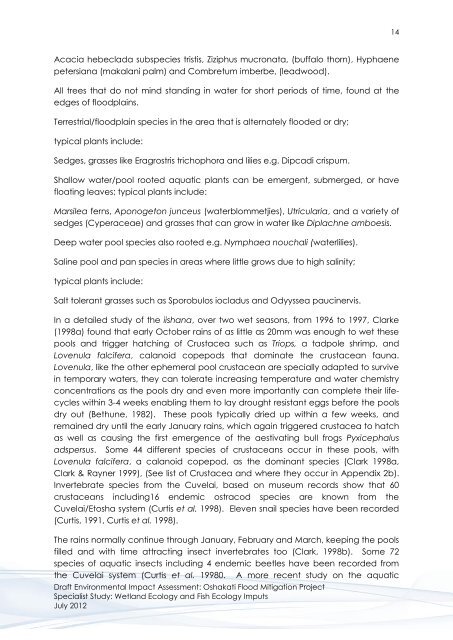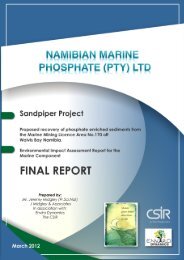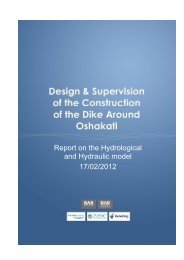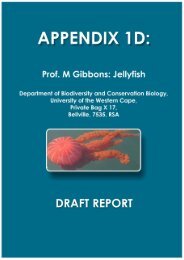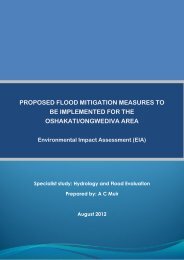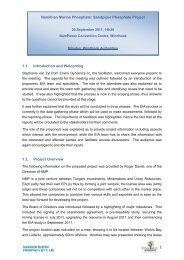Wetland & Fish Ecology - Enviro Dynamics Namibia
Wetland & Fish Ecology - Enviro Dynamics Namibia
Wetland & Fish Ecology - Enviro Dynamics Namibia
You also want an ePaper? Increase the reach of your titles
YUMPU automatically turns print PDFs into web optimized ePapers that Google loves.
14<br />
Acacia hebeclada subspecies tristis, Ziziphus mucronata, (buffalo thorn), Hyphaene<br />
petersiana (makalani palm) and Combretum imberbe, (leadwood).<br />
All trees that do not mind standing in water for short periods of time, found at the<br />
edges of floodplains.<br />
Terrestrial/floodplain species in the area that is alternately flooded or dry;<br />
typical plants include:<br />
Sedges, grasses like Eragrostris trichophora and lilies e.g. Dipcadi crispum.<br />
Shallow water/pool rooted aquatic plants can be emergent, submerged, or have<br />
floating leaves; typical plants include:<br />
Marsilea ferns, Aponogeton junceus (waterblommetjies), Utricularia, and a variety of<br />
sedges (Cyperaceae) and grasses that can grow in water like Diplachne amboesis.<br />
Deep water pool species also rooted e.g. Nymphaea nouchali (waterlilies).<br />
Saline pool and pan species in areas where little grows due to high salinity;<br />
typical plants include:<br />
Salt tolerant grasses such as Sporobulos iocladus and Odyyssea paucinervis.<br />
In a detailed study of the iishana, over two wet seasons, from 1996 to 1997, Clarke<br />
(1998a) found that early October rains of as little as 20mm was enough to wet these<br />
pools and trigger hatching of Crustacea such as Triops, a tadpole shrimp, and<br />
Lovenula falcifera, calanoid copepods that dominate the crustacean fauna.<br />
Lovenula, like the other ephemeral pool crustacean are specially adapted to survive<br />
in temporary waters, they can tolerate increasing temperature and water chemistry<br />
concentrations as the pools dry and even more importantly can complete their lifecycles<br />
within 3-4 weeks enabling them to lay drought resistant eggs before the pools<br />
dry out (Bethune, 1982). These pools typically dried up within a few weeks, and<br />
remained dry until the early January rains, which again triggered crustacea to hatch<br />
as well as causing the first emergence of the aestivating bull frogs Pyxicephalus<br />
adspersus. Some 44 different species of crustaceans occur in these pools, with<br />
Lovenula falcifera, a calanoid copepod, as the dominant species (Clark 1998a,<br />
Clark & Rayner 1999), (See list of Crustacea and where they occur in Appendix 2b).<br />
Invertebrate species from the Cuvelai, based on museum records show that 60<br />
crustaceans including16 endemic ostracod species are known from the<br />
Cuvelai/Etosha system (Curtis et al. 1998). Eleven snail species have been recorded<br />
(Curtis, 1991, Curtis et al. 1998).<br />
The rains normally continue through January, February and March, keeping the pools<br />
filled and with time attracting insect invertebrates too (Clark, 1998b). Some 72<br />
species of aquatic insects including 4 endemic beetles have been recorded from<br />
the Cuvelai system (Curtis et al. 19980. A more recent study on the aquatic<br />
Draft <strong>Enviro</strong>nmental Impact Assessment: Oshakati Flood Mitigation Project<br />
Specialist Study: <strong>Wetland</strong> <strong>Ecology</strong> and <strong>Fish</strong> <strong>Ecology</strong> Imputs<br />
July 2012


